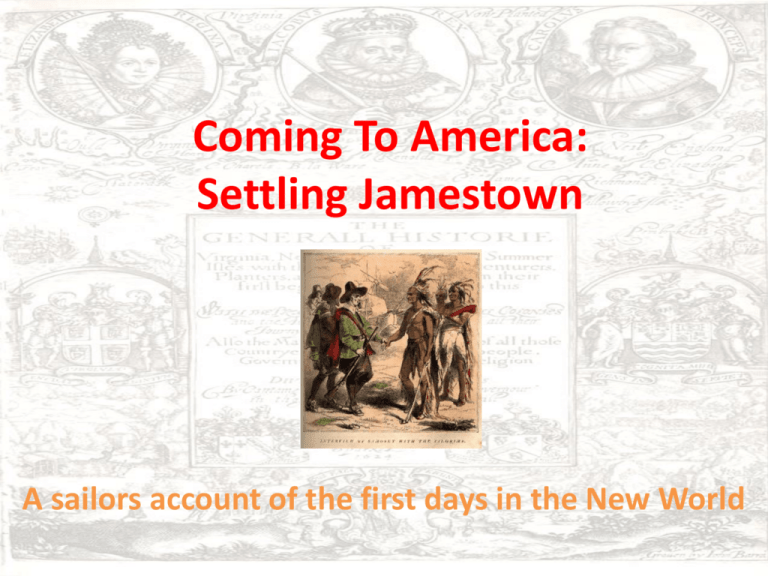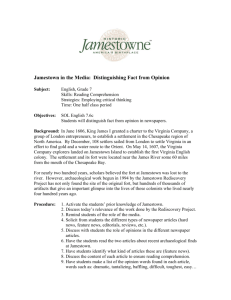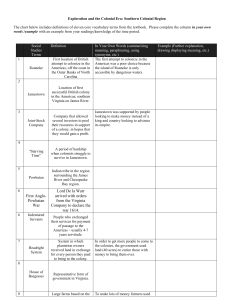Settling Jamestown
advertisement

Coming To America: Settling Jamestown A sailors account of the first days in the New World Coming To America • In 1497 British explorer John Cabot explorer the northern shoreline of North America. • Later, the Virgin Queen, Elizabeth all regions north of the lands of Spain, and named it Virginia after her. • Both England and Spain laid claim to this region. • In 1606 King James I of England chartered two companies to colonize Virginia. – The London (Virginia) Company who ruled Virginia south of Chesapeake Bay – Plymouth Company ruled the north of Virginia (roughly everything north of Chesapeake Bay). What is a Joint Stock Company? Voyage to Virginia • On April 26, 1607, three little ships, the Discovery, the Godspeed, and the Flagship Susan Constant landed on what is now Virginia Beach • The colonists moved slowly up the great Chesapeake Bay on May 14 of 1607, and in the next morning, the very first Virginians went ashore, they built a tiny fort named in James Towne in honor to the king, later it became know as Jamestown. Arriving in America • In April, about four a clock in the morning, we land in the Land of Virginia: – entered into the Bay of Chesapeake. • We landed and explored a little way, but we could find nothing worth speaking of, but fair meadows and godly tall Trees, with such Fresh-waters running through the woods, as I was almost ravished at the first sight. First Encounter with the Natives • At night, there came the Savages creeping on all four, from the Hills like Bears, with their Bowes in their mouths. • They charged us very desperately in the faces, hurt Captain Gabriel Archer in both his hands, and a sailor in two places of the body I will not mention. They then • retired into the Woods with a great noise, and so left us. Settling the New World • The seventh day we began to build up our lodging. • We went further into the Bay, and saw a plain plot of ground. • We past through excellent ground full of flowers and more trees than I had ever seen. Further Relations with Indians • When we came over to the other side, there were many Savages. • They directed us to their town where we were entertained • They went into their houses and brought out mats and laid upon the ground • After we were well satisfied they gave us of their Tobacco, which they took in a pipe made artificially of earth as ours are, but far bigger, with the bowl fashioned together with a piece of fine copper. • When they had ended their dance, the Captain gave us Beads and other trifling Jewels. Settling The New World The Early Fort at Jamestown On the fourteenth day of our landing we set out to work on establishing the fortification. Finishing the Fort • The fifteenth day of June, we had built and finished our Fort which was triangle– Having three Bulwarks at every corner like a half Moon, – Four or five pieces of Artillery mounted in them we had made ourselves sufficiently strong for these Savages. • We had also sewn most of our corn on two Mountains, it sprang a mans height from the ground, – this Country is a fruitful soil, bearing many goodly and fruitful Trees, as Mulberries, Cherries, Walnuts, Cedars, Cypress, Sassafras, and Vines in great abundance. The Starving Time • Powhatan are alarmed by growing number of settlers • Leads to the “Starving Time” (winter of 1609-1610) – Native Americans engage in two acts: 1) Kill livestock 2) Destroy farms • When the winter started the population of Jamestown was five hundred, and by may only sixty-five of them survived. Sickness Among Us • • • • • • The sixt of August there died John Asbie of the bloudie Fluxe. The ninth day died George Flowre of the swelling. The tenth day died William Bruster Gentleman, of a wound given by the Savages, and was buried the eleventh day. The fourteenth day, Jerome Alikock Ancient, died of a wound, the same day Francis Midwinter, Edward Moris Corporalldied suddenly. The fifteenth day, there died Edward Browne and Stephen Galthrope. The sixteenth day, there died Thomas Gower Gentleman. The seventeenth day, there died Thomas Mounslic. The eighteenth day, there died Robert Pennington, and John Martine Gentleman. The nineteenth day, died Drue Pigasse Gentleman. The two and twentieth day of August, there died Captaine Bartholomew Gosnold one of our Councell, he was honourably buried, having all the Ordnance in the Fort shot off with many vollies of small shot. After Captaine Gosnols death, the Councell could hardly agree by the dissention of Captaine Kendall, which afterward was committed about hainous matters which was proved against him. The foure and twentieth day, died Edward Harington and George Walker, and were buried the same day. The sixe and twentieth day, died Kenelme Throgmortine. The seven and twentieth day died William Roods. The eight and twentieth day died Thomas Stoodie, Cape Merchant. The fourth day of September died Thomas Jacob Sergeant. The fift day, there died Benjamin Beast. Our men were destroyed with cruell diseases as Swellings, Fluxes, Burning Fevers, and by warres, and some departed suddenly, but for the most part they died of meere famine. Miserable Famine “There was never Englishmen left in a foreign Country in such misery as we were in this new discovered Virginia. We watched every three nights lying on the bare cold ground what weather came warded all the next day, which brought our men to bee most feeble wretches, Our food was but a small Can of Barley sod in water to five men a day, our drink cold water taken out of the River, which was filled with salt, at a low tide full of slime and filth, which was the destruction of many of our men. Our men night and day groaning in every corner of the Fort most pitiful to hear, Out-cries of our sick men without relief every night and day for the space of six weeks…” The Starving Time • “In terms of corn, provision, and contribution from the savages, we had nothing but mortal wounds, with clubs and arrows. Our hogs, hens, goats, sheep, horse, or whatever else had lived had already been consumed by our commanders and officers. Some small portions sometimes we tasted.” The Starving Time • “There remained not past sixty men, women, and children, most miserable and poor creatures. Those were preserved for the most part by roots, herbs, acorns, walnuts, berries, and now and then a little fish. So great was our famine, that a Savage we slew, and buried, the poor sort took him up again and eat him, and so did divers one another and stewed with roots and herbs.” The Starving Time • “And one amongst the rest did kill his wife, powdered her, and had eaten part of her before it was known, for which he was executed, as he well deserved. Now whether she was better off roasted, boiled, or carbonated, I know not, but of such a dish as powdered wife I never heard of. This was that time, which still to this day we call the starving time. It were too vile to say…this in ten days more, would have supplanted us all with death…” Describe the differences you see between these two civilizations… What factors might account for these differences? How might these differences been reflected in day-to-day activity? Colonists have a Troubled Start • Problems arising that need solving 1) Disease from contaminated water 2) Hunger came second 3) People would not work Role of John Smith • When they landed John Smith was in chains • A large number of the Virginians were very arrogant, and consider themselves too dignified for ordinary labor. • Smith took charge: – “Those who will not work, will not eat” – Forced colonists to farm – Persuaded Powhatan people to help provide food. The Development of Industry • After winter, England sent another group with new supplies, and people- among them, John Rolfe • Abandon Jamestown and move South, down river • Credited for the creation of Jamestown’s first industry: Tobacco Cultivation Tobacco in New World • The native tobacco from Virginia was not liked by the English settlers, nor did it appeal to the market in England. • However, Rolfe wanted to introduce sweeter strains from Trinidad – using the hard-to-obtain Spanish seeds he brought with him. – John Rolfe experimented by cross breeding tobacco from Brazil with harsh strain of the weed that local Native Americans had grown for years – In 1611, Rolfe is credited with being the first to commercially cultivate Nicotiana tabacum • Exported 1.5 million pounds of “brown gold” each year So how do we get from here….. To here….what do you need? The Headright System 1) Anyone who paid for their or another’s passage to Virginia received 50 acres of land 2) Term “plantation´ used to describe the people who settled the land grant (became known as the land itself) 3) To work the plantations, owners imported Indentured Servants 1) in exchange for passage, food, and shelter, agreed to a limited term of servitude (4-7 years)- lower class people 4) First African Laborers 1) Africans arrived in Virginia aboard a Dutch merchant ship in 1619 2) 20 Africans were treated as Indentured Servants (not slaves) 1) Received land and freedom after a number of years




